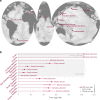A transdisciplinary and community-driven database to unravel subduction zone initiation
- PMID: 32719322
- PMCID: PMC7385650
- DOI: 10.1038/s41467-020-17522-9
A transdisciplinary and community-driven database to unravel subduction zone initiation
Abstract
Subduction zones are pivotal for the recycling of Earth's outer layer into its interior. However, the conditions under which new subduction zones initiate are enigmatic. Here, we constructed a transdisciplinary database featuring detailed analysis of more than a dozen documented subduction zone initiation events from the last hundred million years. Our initial findings reveal that horizontally forced subduction zone initiation is dominant over the last 100 Ma, and that most initiation events are proximal to pre-existing subduction zones. The SZI Database is expandable to facilitate access to the most current understanding of subduction zone initiation as research progresses, providing a community platform that establishes a common language to sharpen discussion across the Earth Science community.
Conflict of interest statement
The authors declare no competing interests.
Figures






Similar articles
-
Implications for metal and volatile cycles from the pH of subduction zone fluids.Nature. 2016 Nov 17;539(7629):420-424. doi: 10.1038/nature20103. Nature. 2016. PMID: 27853207
-
Plate tectonics on the Earth triggered by plume-induced subduction initiation.Nature. 2015 Nov 12;527(7577):221-5. doi: 10.1038/nature15752. Nature. 2015. PMID: 26560300
-
3D anisotropic structure of the Japan subduction zone.Sci Adv. 2021 Jan 20;7(4):eabc9620. doi: 10.1126/sciadv.abc9620. Print 2021 Jan. Sci Adv. 2021. PMID: 33523923 Free PMC article.
-
Subducting carbon.Nature. 2019 Oct;574(7778):343-352. doi: 10.1038/s41586-019-1643-z. Epub 2019 Oct 16. Nature. 2019. PMID: 31619791 Review.
-
Electromagnetic exploration of the oceanic mantle.Proc Jpn Acad Ser B Phys Biol Sci. 2015;91(6):203-22. doi: 10.2183/pjab.91.203. Proc Jpn Acad Ser B Phys Biol Sci. 2015. PMID: 26062736 Free PMC article. Review.
Cited by
-
Anisotropic thermal conductivity of antigorite along slab subduction impacts seismicity of intermediate-depth earthquakes.Nat Commun. 2024 Jun 18;15(1):5198. doi: 10.1038/s41467-024-49418-3. Nat Commun. 2024. PMID: 38890301 Free PMC article.
-
Sulfur disproportionation in deep COHS slab fluids drives mantle wedge oxidation.Sci Adv. 2024 Mar 22;10(12):eadj2770. doi: 10.1126/sciadv.adj2770. Epub 2024 Mar 20. Sci Adv. 2024. PMID: 38507499 Free PMC article.
-
Onset of double subduction controls plate motion reorganisation.Nat Commun. 2024 Feb 19;15(1):1513. doi: 10.1038/s41467-024-44764-8. Nat Commun. 2024. PMID: 38374036 Free PMC article.
-
Hot versus cold subduction initiation.Natl Sci Rev. 2024 Jan 8;11(2):nwae012. doi: 10.1093/nsr/nwae012. eCollection 2024 Feb. Natl Sci Rev. 2024. PMID: 38287992 Free PMC article.
-
Subduction initiation triggered the Caribbean large igneous province.Nat Commun. 2023 Feb 11;14(1):786. doi: 10.1038/s41467-023-36419-x. Nat Commun. 2023. PMID: 36774439 Free PMC article.
References
-
- Stern RJ. Subduction initiation: spontaneous and induced. Earth Planet. Sci. Lett. 2004;226:275–292.
-
- Stern, R. J. & Gerya, T. Subduction initiation in nature and models: a review. Tectonophysics746, 173–198 (2018). A recent review of state-of-the-art geodynamic SZI modelling and its comparison with observations that highlights the presence of subduction polarity reversals, SZI via transform collapse, and plume induced SZI.
-
- Crameri F, Conrad CP, Montési L, Lithgow-Bertelloni CR. The dynamic life of an oceanic plate. Tectonophysics. 2019;760:107–135.
-
- Crameri, F., Shephard, G. E. & Conrad, C. P. In Reference Module in Earth Systems and Environmental Sciences (Elsevier, 2019).
-
- Gurnis M, Hall C, Lavier L. Evolving force balance during incipient subduction. Geochem. Geophys. Geosyst. 2004;5:Q07001–Q07001.
Publication types
LinkOut - more resources
Full Text Sources


